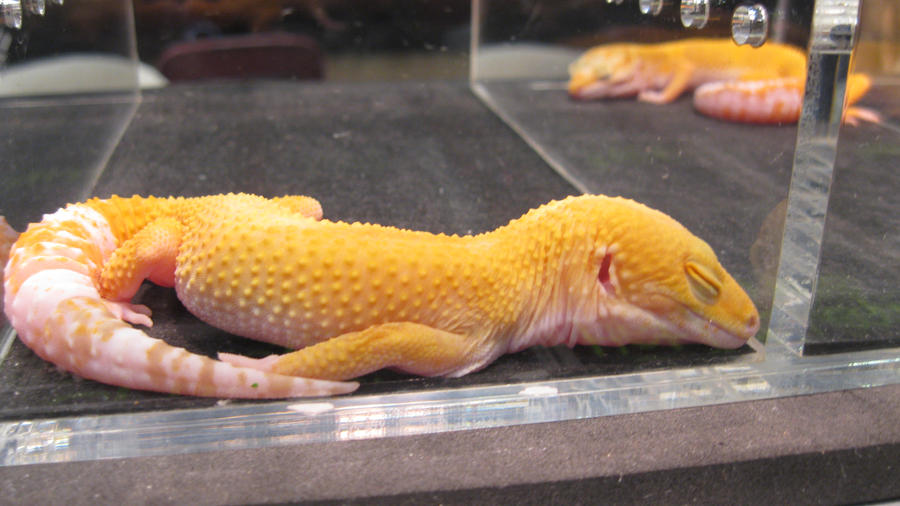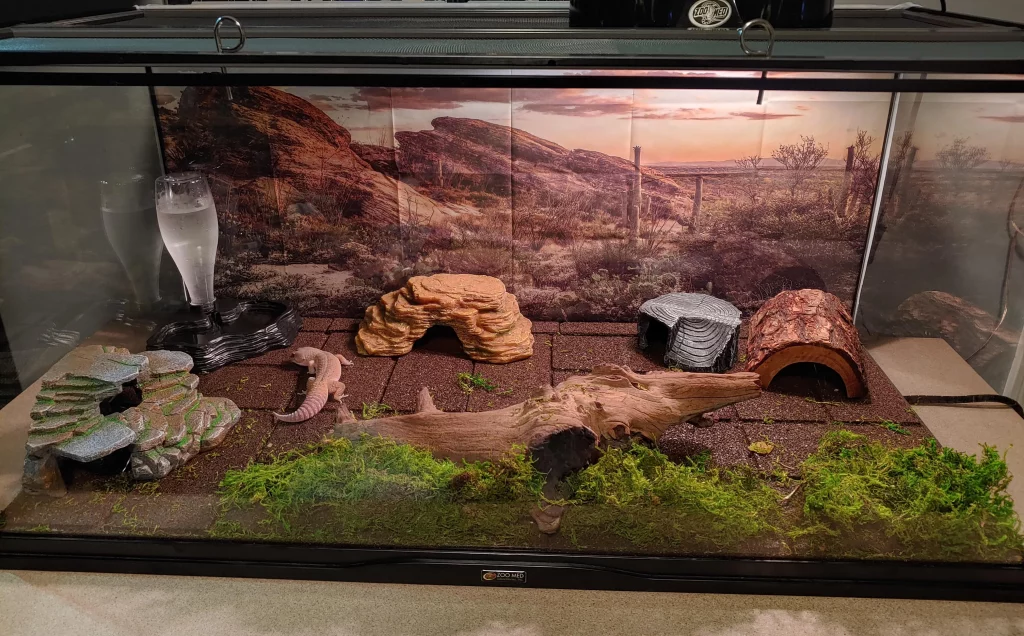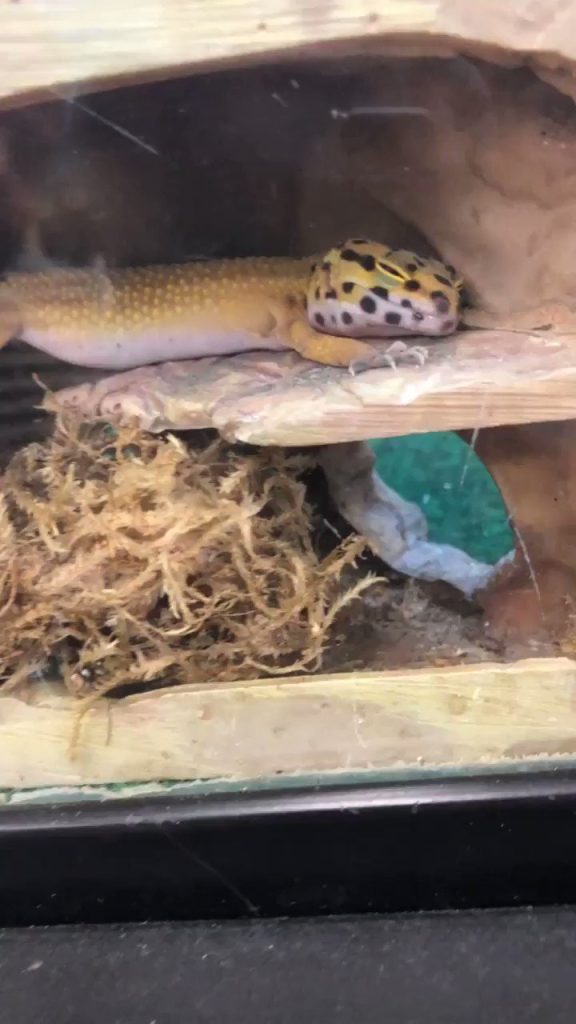Eublepharis macularius, a fascinating lizard with a stunning look and mild disposition, is the leopard gecko. Leopard geckos’ behavior pattern is one of its most fascinating characteristics, which begs the question- are leopard geckos nocturnal or diurnal organisms.
In contrast to nocturnal animals, pet leopard gecko sleep during the day and you may find them much active at twilight hours . As a result Leonard geckos are crepuscular.
Crepuscular Vs Nocturnal
Animals that are crepuscular are most active at dawn and dusk, which mark the change from daytime to night. Because they are aware that predators are less active at twilight, many animals make use of the time to feed, look for water, and participate in other activities.
On the other side, nocturnal creatures are most active at night. They have adapted to the colder weather and darkness, which has benefits including helping them identify food that is active at night and avoiding predators.
Are Leopard Geckos Nocturnal Or Diurnal?

Most of the time, leopard geckos are cold-blooded, that will be curled up in hiding places or shelters, sleeping. They don’t routinely sunbathe like some reptiles do.
This does not necessary imply that leopard geckos are active all night. However, most leopard geckos are crepuscular or cathemeral tendencies and are neither solely nocturnal or diurnal in their activity.
Because they are crepuscular, these reptiles have fewer rivals for food. Leopard geckos , when kept as pet has preference for twilight hours for their principal activity is essentially a survival strategy.
The majority of the day is spent sleeping for pet leopard geckos in recesses and enclosures.
Where Does Leopard Geckos Live?
Leopard geckos are indigenous to South Asia’s semi-arid and desert areas, notably Afghanistan, Pakistan, India, and Iran.
They frequently inhabit stony grasslands, desert regions, and arid scrublands in their native environment. They have developed to survive in these dry conditions, when day and nighttime temperatures can differ greatly.
Leopard Gecko Maintenance
Leopard gecko’s are intriguing lizards with distinctive habits that have become well-liked as pets. A leopard gecko’s daytime activity depends largely on a range of variables that have a big influence on its energy, mood, and general well-being.
These reptiles slumber for 12 hours of the day, and because the creatures appear to be dead, you would worry that they are ill.
1. Enclosure Setup

Be mindful of the leopard geckos’ need to hibernate both during the day and at night when constructing their home. You must create a setting that is comparable to where the animal naturally hides—under rocks.
One adult leopard gecko requires a minimum tank size of 20 gallons, however bigger tanks are advised to give them more room to explore.
Burrowing and basking are two of the leopard geckos’ natural behaviors, which are crucial to their life and overall health. These actions are necessary for their thermal regulation, ease, and safety and are intimately tied to their natural habitat.
2. Feeding The Reptile
Only when they are actively moving will leopard geckos eat. You must set the animal up with a regular feeding plan because of this.
Leopard geckos should eat primarily adequately size bugs like crickets, meal worms, Dubia roaches, and occasionally wax worms or super worms as they are insectivores. You can also give them treats like natural Nutri Bites.
Additionally, their bodies retain extra fat beneath the skin, particularly in their tails. The animal can therefore go for an entire week without sustenance. As a result, the animal will occasionally eat less, which could be misconstrued for illness.
3. Suitable Lighting
Leopard geckos need the same amount of light as they need in the wild to survive as pets. As a result, you do not need to give the animal with artificial lighting at night.
Because of the separation between day and night, the animal may develop a regular sleeping pattern. Because of unpredictable sleeping habits, the animal is more prone to feel stress when artificial lights are used.
4. Temperature
Leopard geckos, like other reptiles, require a temperature differential in their terrarium to stay healthy. The basking surface should be kept between 94 and 97 degrees Fahrenheit.
Leopard geckos do not need UVB lights, but they do require a consistent day-night cycle.
Where Do Leopard Geckos Sleep?

Leopard geckos are nocturnal creatures that prefer to find secure havens for rest and sleep during the day. Geckos sleep in concealment because they are small, non-venomous, and weak.
They can bite, however they are vulnerable to a variety of predators. They automatically disguise themselves when sleeping because this is when they are most vulnerable. Leopard geckos are known to dig burrows to escape the hot summer heat in their natural habitat.
They can make their own burrows in the substrate or exploit existing hiding spots to create improvised tunnels in which they can unwind and rest in confinement. Leopard geckos sleep for an average of 12 to 13 hours every day.
Do Geckos Sleep In Groups Or Alone?
Leopard geckos, by definition creatures of solitude, prefer to live alone rather than in groups. Geckos of substantially various sizes, as well as two males, sub-adult males, mating females, or two males, shouldn’t be kept together.
If they intend to keep numerous geckos together, they must also consider the size of the cage. This allows them to have their own territory, access to resources, and reduces the likelihood of territorial conflicts.
As a result, each gecko may live a less demanding and more calm life, which is critical for their overall health and well-being.
Conclusion
Leopard geckos are crepuscular, not nocturnal. Given that both nocturnal and crepuscular species sleep during the day, the distinction is insignificant.
Many aspects, such as moisture and temperature levels, must be considered when deciding if your pet should be kept in a diurnal or nocturnal environment.
By maintaining these tips in mind, you can help ensure that your leopard gecko is healthy and happy regardless of its activity level.
FAQs
Do I need to turn my leopard geckos light off at night?
According to the time of year, your leopard gecko may require their lights to be turned off between 8 and 10 p.m. and turned back on at 8 a.m. the next day. You must mimic a day and night cycle, therefore be constant with natural lighting.
Why is my leopard gecko active during the day?
Yes, the majority of leopard geckos are nocturnal and crepuscular. Leopard geckos are most active around dawn and dusk, as well as at night, in contrast to bearded dragons, who are active all day.
Should leopard geckos be in the dark at night?
Leopard geckos do not use light at night because their sleep-wake cycle requires complete darkness. If you need to give them some light so you are able to see them after the lights go out, use a blue light for a short exposure to UVB while making sure it is turned off before nightfall.
Are leopard geckos active at night?
Leopard gecko might sleep during the day, but are often not visible. In actuality, leopard geckos snooze for 12 to 13 hours every day on average, meaning they are most active at night, though. In their leopard gecko’s enclosures, they sleep curled up, whether it’s dry or damp.
How do you take care of a leopard gecko at night?
At night, switch off the heat lamp but keep the temperature over 18 °C by using a heat mat or ceramic heat lamp. Leopard geckos need a habitat that is primarily dry.



